Evaluation of CMIP6 Models and Multi-Model Ensemble for Extreme Precipitation over Arid Central Asia
Abstract
:1. Introduction
2. Materials and Methods
2.1. Study Region
2.2. Data
2.3. Methodology
2.3.1. Extreme Precipitation Indices
2.3.2. Model Performance Metrics
2.3.3. Multi-Model Ensemble Methods
2.3.4. Methodological Flowchart
3. Results
3.1. Spatial Evaluation
3.1.1. Spatial Bias Analysis
3.1.2. Taylor Diagram-Based Spatial Simulation Ability Analysis
3.2. Temporal Evaluation
3.2.1. Trend Evaluation
3.2.2. Evaluation of Interannual Variability
3.3. Overall Model Performance
3.4. Multi-Modal Ensemble Performance Evaluation
4. Discussion
5. Conclusions
Supplementary Materials
Author Contributions
Funding
Data Availability Statement
Conflicts of Interest
References
- World Meteorological Organization (WMO). State of the Global Climate 2021; World Meteorological Organization (WMO): Geneva, Switzerland, 2022; p. 2. [Google Scholar]
- Donat, M.G.; Lowry, A.L.; Alexander, L.V.; O’Gorman, P.A.; Maher, N. More extreme precipitation in the world’s dry and wet regions. Nat. Clim. Chang. 2016, 6, 508–513. [Google Scholar] [CrossRef]
- Gessner, U.; Naeimi, V.; Klein, I.; Kuenzer, C.; Klein, D.; Dech, S. The relationship between precipitation anomalies and satellite-derived vegetation activity in Central Asia. Glob. Planet. Chang. 2013, 110, 74–87. [Google Scholar] [CrossRef]
- Maxwell, S.L.; Butt, N.; Maron, M.; McAlpine, C.A.; Chapman, S.; Ullmann, A.; Segan, D.B.; Watson, J.E.M. Conservation implications of ecological responses to extreme weather and climate events. Divers. Distrib. 2018, 25, 613–625. [Google Scholar] [CrossRef]
- Runde, I.; Zobel, Z.; Schwalm, C. Human and natural resource exposure to extreme drought at 1.0 °C–4.0 °C warming levels. Environ. Res. Lett. 2022, 17, 064005. [Google Scholar] [CrossRef]
- Garreaud, R.D.; Boisier, J.P.; Rondanelli, R.; Montecinos, A.; Sepúlveda, H.H.; Veloso-Aguila, D. The Central Chile Mega Drought (2010–2018): A climate dynamics perspective. Int. J. Climatol. 2019, 40, 421–439. [Google Scholar] [CrossRef]
- Zhao, Z.; Luo, Y.; Huang, J. The detection of the CMIP5 climate model to see the development of CMIP6 earth system models. Clim. Chang. Res. 2018, 14, 643–648. [Google Scholar] [CrossRef]
- Chen, H.; Sun, J.; Lin, W.; Xu, H. Comparison of CMIP6 and CMIP5 models in simulating climate extremes. Sci. Bull. 2020, 65, 1415–1418. [Google Scholar] [CrossRef]
- Dong, T.; Dong, W. Evaluation of extreme precipitation over Asia in CMIP6 models. Clim. Dyn. 2021, 57, 1751–1769. [Google Scholar] [CrossRef]
- Kim, Y.-H.; Min, S.-K.; Zhang, X.; Sillmann, J.; Sandstad, M. Evaluation of the CMIP6 multi-model ensemble for climate extreme indices. Weather Clim. Extrem. 2020, 29, 100269. [Google Scholar] [CrossRef]
- Rivera, J.A.; Arnould, G. Evaluation of the ability of CMIP6 models to simulate precipitation over Southwestern South America: Climatic features and long-term trends (1901–2014). Atmos. Res. 2020, 241, 104953. [Google Scholar] [CrossRef]
- Fan, X.; Miao, C.; Duan, Q.; Shen, C.; Wu, Y. The performance of CMIP6 versus CMIP5 in simulating temperature extremes over the global land surface. J. Geophys. Res. Atmos. 2020, 125, e2020JD033031. [Google Scholar] [CrossRef]
- Gupta, V.; Singh, V.; Jain, M.K. Assessment of precipitation extremes in India during the 21st century under SSP1-1.9 mitigation scenarios of CMIP6 GCMs. J. Hydrol. 2020, 590, 125422. [Google Scholar] [CrossRef]
- Li, J.; Huo, R.; Chen, H.; Zhao, Y.; Zhao, T. Comparative Assessment and Future Prediction Using CMIP6 and CMIP5 for Annual Precipitation and Extreme Precipitation Simulation. Front. Earth Sci. 2021, 9, 687976. [Google Scholar] [CrossRef]
- Guan, J.; Yao, J.; Li, M.; Li, D.; Zheng, J. Historical changes and projected trends of extreme climate events in Xinjiang, China. Clim. Dyn. 2022, 58, 1753–1774. [Google Scholar] [CrossRef]
- Erlandsen, H.B.; Parding, K.M.; Benestad, R.; Mezghani, A.; Pontoppidan, M. A Hybrid Downscaling Approach for Future Temperature and Precipitation Change. J. Appl. Meteorol. Climatol. 2020, 59, 1793–1807. [Google Scholar] [CrossRef]
- Rashid, M.B.; Hossain, S.S.; Mannan, M.A.; Parding, K.M.; Hygen, H.O.; Benestad, R.E.; Mezghani, A. Climate change projections of maximum temperature in the pre-monsoon season in Bangladesh using statistical downscaling of global climate models. Adv. Sci. Res. 2021, 18, 99–114. [Google Scholar] [CrossRef]
- Jiang, S.; Jiang, Z.; Li, W. Evaluation of the Extreme Temperature and Its Trend in China Simulated CMIP5 models. Clim. Chang. Res. 2017, 13, 11–24. [Google Scholar] [CrossRef]
- Ge, F.; Zhu, S.; Luo, H.; Zhi, X.; Wang, H. Future changes in precipitation extremes over Southeast Asia: Insights from CMIP6 multi-model ensemble. Environ. Res. Lett. 2021, 16, 024013. [Google Scholar] [CrossRef]
- Jiang, W.H.; Chen, H.P. Assessment and projection of changes in temperature extremes over the mid-high latitudes of Asia based on CMIP6 models. Trans. Atmos. Sci. 2021, 44, 592–603. [Google Scholar] [CrossRef]
- Liu, Z.; Lu, J.; Huang, J.; Chen, X.; Zeng, Q. Potential evapotranspiration and drought effects of Poyang Lake Basin based on global climate model aggregation. Acta Ecol. Sin. 2021, 41, 6936–6948. [Google Scholar]
- Bishop, C.H.; Abramowitz, G. Climate model dependence and the replicate Earth paradigm. Clim. Dyn. 2012, 41, 885–900. [Google Scholar] [CrossRef]
- Bai, H.; Xiao, D.; Wang, B.; Liu, D.L.; Feng, P.; Tang, J. Multi-model ensemble of CMIP6 projections for future extreme climate stress on wheat in the North China plain. Int. J. Climatol. 2020, 41, E171–E186. [Google Scholar] [CrossRef]
- Zarrin, A.; Dadashi-Roudbari, A.; Hassani, S. Historical variability and future changes in seasonal extreme temperature over Iran. Theor. Appl. Climatol. 2021, 146, 1227–1248. [Google Scholar] [CrossRef]
- Ma, Q.; Zhang, J.; Game, A.T.; Chang, Y.; Li, S. Spatiotemporal variability of summer precipitation and precipitation extremes and associated large-scale mechanisms in Central Asia during 1979–2018. J. Hydrol. X 2020, 8, 100061. [Google Scholar] [CrossRef]
- Yao, J.; Zeng, Y.; Li, J.; Yang, L. A Review of Dry-Wet Climate Change and Extreme Precipitation in Central Asia. Adv. Meteorol. Sci. Technol. 2020, 10, 7–14. [Google Scholar] [CrossRef]
- Liang-Liang, L.; Jian, L.; Ru-Cong, Y. Evaluation of CMIP6 HighResMIP models in simulating precipitation over Central Asia. Adv. Clim. Chang. Res. 2022, 13, 1–13. [Google Scholar] [CrossRef]
- Zhang, M.; Chen, Y.; Shen, Y.; Li, B. Tracking climate change in Central Asia through temperature and precipitation extremes. J. Geogr. Sci. 2019, 29, 3–28. [Google Scholar] [CrossRef]
- Hu, W.; Yao, J.; He, Q.; Chen, J. Changes in precipitation amounts and extremes across Xinjiang (northwest China) and their connection to climate indices. PeerJ 2021, 9, e10792. [Google Scholar] [CrossRef]
- Tian, Y.; Yan, Z.; Li, Z. Spatial and Temporal Variations of Extreme Precipitation in Central Asia during 1982–2020. Atmosphere 2021, 13, 60. [Google Scholar] [CrossRef]
- Zhang, X.; Chen, Y.; Fang, G.; Li, Y.; Li, Z.; Wang, F.; Xia, Z. Observed changes in extreme precipitation over the Tienshan Mountains and associated large-scale climate teleconnections. J. Hydrol. 2022, 606, 127457. [Google Scholar] [CrossRef]
- Zhang, M.; Chen, Y.; Shen, Y.; Li, Y. Changes of precipitation extremes in arid Central Asia. Quat. Int. 2017, 436, 16–27. [Google Scholar] [CrossRef]
- Xu, P.; Wang, L.; Ming, J. Central Asian Precipitation Extremes Affected by an Intraseasonal Planetary Wave Pattern. J. Clim. 2022, 35, 2603–2616. [Google Scholar] [CrossRef]
- Khadgarai, S.; Kumar, V.; Pradhan, P.K. The Connection between Extreme Precipitation Variability over Monsoon Asia and Large-Scale Circulation Patterns. Atmosphere 2021, 12, 1492. [Google Scholar] [CrossRef]
- Jiang, J.; Zhou, T.; Chen, X.; Zhang, L. Future changes in precipitation over Central Asia based on CMIP6 projections. Environ. Res. Lett. 2020, 15, 054009. [Google Scholar] [CrossRef]
- Zhao, Y.; Qian, C.; Zhang, W.; He, D.; Qi, Y. Extreme temperature indices in Eurasia in a CMIP6 multi-model ensemble: Evaluation and projection. Int. J. Climatol. 2021, 41, 5368–5385. [Google Scholar] [CrossRef]
- Fan, X.; Duan, Q.; Shen, C.; Wu, Y.; Xing, C. Evaluation of historical CMIP6 model simulations and future projections of temperature over the Pan-Third Pole region. Environ. Sci. Pollut. Res. Int. 2022, 29, 26214–26229. [Google Scholar] [CrossRef]
- Lin, W.; Chen, H. Assessment of model performance of precipitation extremes over the mid-high latitude areas of Northern Hemisphere: From CMIP5 to CMIP6. Atmos. Ocean. Sci. Lett. 2020, 13, 598–603. [Google Scholar] [CrossRef]
- Zhang, J.; Wang, F. Future changes in extreme precipitation in central Asia with 1.5–4 °C global warming based on Coupled Model Intercomparison Project Phase 6 simulations. Int. J. Climatol. 2022, 42, 8509–8525. [Google Scholar] [CrossRef]
- Dike, V.N.; Lin, Z.; Fei, K.; Langendijk, G.S.; Nath, D. Evaluation and multimodel projection of seasonal precipitation extremes over central Asia based on CMIP6 simulations. Int. J. Climatol. 2022, 42, 7228–7251. [Google Scholar] [CrossRef]
- Hu, Z.; Zhou, Q.; Chen, X.; Li, J.; Li, Q.; Chen, D.; Liu, W.; Yin, G. Evaluation of three global gridded precipitation data sets in central Asia based on rain gauge observations. Int. J. Climatol. 2018, 38, 3475–3493. [Google Scholar] [CrossRef]
- Yu, Y.; Schneider, U.; Yang, S.; Becker, A.; Ren, Z. Evaluating the GPCC Full Data Daily Analysis Version 2018 through ETCCDI indices and comparison with station observations over mainland of China. Theor. Appl. Climatol. 2020, 142, 835–845. [Google Scholar] [CrossRef]
- Dilinuer, T.; Yao, J.; Chen, J.; Zhao, Y.; Mao, W.; Li, J.; Yang, L. Systematical Evaluation of Three Gridded Daily Precipitation Products Against Rain Gauge Observations Over Central Asia. Front. Earth Sci. 2021, 9, 699628. [Google Scholar] [CrossRef]
- Song, L.; Xu, C.; Long, Y.; Lei, X.; Suo, N.; Cao, L. Performance of Seven Gridded Precipitation Products over Arid Central Asia and Subregions. Remote Sens. 2022, 14, 6039. [Google Scholar] [CrossRef]
- Chen, X.; Wang, S.; Hu, Z.; Zhou, Q.; Hu, Q. Spatiotemporal characteristics of seasonal precipitation and their relationships with ENSO in Central Asia during 1901–2013. J. Geogr. Sci. 2018, 28, 1341–1368. [Google Scholar] [CrossRef]
- Yu, Y.; Chen, X.; Disse, M.; Cyffka, B.; Lei, J.; Zhang, H.; Brieden, A.; Welp, M.; Abuduwaili, J.; Li, Y.; et al. Climate change in Central Asia: Sino-German cooperative research findings. Sci. Bull. 2020, 65, 689–692. [Google Scholar] [CrossRef] [PubMed]
- Shen, C.; Zha, J.; Zhao, D.; Wu, J.; Fan, W.; Yang, M.; Li, Z. Estimating centennial-scale changes in global terrestrial near-surface wind speed based on CMIP6 GCMs. Environ. Res. Lett. 2021, 16, 084039. [Google Scholar] [CrossRef]
- Shen, C.; Zha, J.; Li, Z.; Azorin-Molina, C.; Deng, K.; Minola, L.; Chen, D. Evaluation of global terrestrial near-surface wind speed simulated by CMIP6 models and their future projections. Ann. N. Y. Acad. Sci. 2022, 1518, 249–263. [Google Scholar] [CrossRef]
- Chen, X.; Li, B.; Li, Q.; Li, J.; Abdulla, S. Spatio-temporal pattern and changes of evapotranspiration in arid Central Asia and Xinjiang of China. J. Arid. Land 2012, 4, 105–113. [Google Scholar] [CrossRef]
- Guo, H.; Bao, A.; Chen, T.; Zheng, G.; Wang, Y.; Jiang, L.; De Maeyer, P. Assessment of CMIP6 in simulating precipitation over arid Central Asia. Atmos. Res. 2021, 252, 105451. [Google Scholar] [CrossRef]
- Ziese, M.; Rauthe-Schöch, A.; Becker, A.; Finger, P.; Rustemeier, E.; Schneider, U. GPCC Full Data Daily Version 2020 at 1.0°: Daily Land-Surface Precipitation from Rain-Gauges Built on GTS-Based and Historic Data; Global Precipitation Climatology Centre at Deutscher Wetterdienst: Offenbach, Germany, 2021. [Google Scholar]
- Taylor, K.E. Summarizing multiple aspects of model performance in a single diagram. J. Geophys. Res. Atmos. 2001, 106, 7183–7192. [Google Scholar] [CrossRef]
- Ortega, G.; Arias, P.A.; Villegas, J.C.; Marquet, P.A.; Nobre, P. Present-day and future climate over central and South America according to CMIP5/CMIP6 models. Int. J. Climatol. 2021, 41, 6713–6735. [Google Scholar] [CrossRef]
- Chen, W.; Jiang, Z.; Li, L. Probabilistic Projections of Climate Change over China under the SRES A1B Scenario Using 28 AOGCMs. J. Clim. 2011, 24, 4741–4756. [Google Scholar] [CrossRef]
- Li, W.; Jiang, Z.; Xu, J.; Li, L. Extreme Precipitation Indices over China in CMIP5 Models. Part I: Model Evaluation. J. Clim. 2015, 28, 8603–8619. [Google Scholar] [CrossRef]
- Balhane, S.; Driouech, F.; Chafki, O.; Manzanas, R.; Chehbouni, A.; Moufouma-Okia, W. Changes in mean and extreme temperature and precipitation events from different weighted multi-model ensembles over the northern half of Morocco. Clim. Dyn. 2021, 58, 389–404. [Google Scholar] [CrossRef]
- Liu, Z.; Huang, J.; Xiao, X.; Tong, X. The capability of CMIP6 models on seasonal precipitation extremes over Central Asia. Atmos. Res. 2022, 278, 106364. [Google Scholar] [CrossRef]
- Akinsanola, A.A.; Ongoma, V.; Kooperman, G.J. Evaluation of CMIP6 models in simulating the statistics of extreme precipitation over Eastern Africa. Atmos. Res. 2021, 254, 105509. [Google Scholar] [CrossRef]
- Srivastava, A.; Grotjahn, R.; Ullrich, P.A. Evaluation of historical CMIP6 model simulations of extreme precipitation over contiguous US regions. Weather. Clim. Extrem. 2020, 29, 100268. [Google Scholar] [CrossRef]
- Luo, N.; Guo, Y. Impact of Model Resolution on the Simulation of Precipitation Extremes over China. Sustainability 2021, 14, 25. [Google Scholar] [CrossRef]
- Zhou, T.; Zhang, W.; Zhang, L.; Zhang, X.; Qian, Y.; Peng, D.; Ma, S.; Dong, B. The dynamic and thermodynamic processes dominating the reduction of global land monsoon precipitation driven by anthropogenic aerosols emission. Sci. China Earth Sci. 2020, 63, 919–933. [Google Scholar] [CrossRef]
- Freychet, N.; Tett, S.F.B.; Tian, F.; Li, S.; Dong, B.; Sparrow, S. Physical processes of summer extreme rainfall interannual variability in Eastern China—Part II: Evaluation of CMIP6 models. Clim. Dyn. 2022, 59, 455–469. [Google Scholar] [CrossRef]
- Chen, C.-A.; Hsu, H.-H.; Liang, H.-C. Evaluation and comparison of CMIP6 and CMIP5 model performance in simulating the seasonal extreme precipitation in the Western North Pacific and East Asia. Weather Clim. Extrem. 2021, 31, 100303. [Google Scholar] [CrossRef]
- Keupp, L.; Hertig, E.; Kaspar-Ott, I.; Pollinger, F.; Ring, C.; Paeth, H.; Jacobeit, J. Weighted multi-model ensemble projection of extreme precipitation in the Mediterranean region using statistical downscaling. Theor. Appl. Climatol. 2019, 138, 1269–1295. [Google Scholar] [CrossRef]
- Ring, C.; Pollinger, F.; Kaspar-Ott, I.; Hertig, E.; Jacobeit, J.; Paeth, H. A comparison of metrics for assessing state-of-the-art climate models and implications for probabilistic projections of climate change. Clim. Dyn. 2018, 50, 2087–2106. [Google Scholar] [CrossRef]
- Ring, C.; Mannig, B.; Pollinger, F.; Paeth, H. Uncertainties in the simulation of precipitation in selected regions of humid and dry climate. Int. J. Climatol. 2016, 36, 3521–3538. [Google Scholar] [CrossRef]
- Cox, P.M.; Pearson, D.; Booth, B.B.; Friedlingstein, P.; Huntingford, C.; Jones, C.D.; Luke, C.M. Sensitivity of tropical carbon to climate change constrained by carbon dioxide variability. Nature 2013, 494, 341–344. [Google Scholar] [CrossRef]
- Duan, C.; Wang, P.; Cao, W.; Wang, X.; Wu, R.; Cheng, Z. Improving the Spring Air Temperature Forecast Skills of BCC_CSM1.1 (m) by Spatial Disaggregation and Bias Correction: Importance of Trend Correction. Atmosphere 2021, 12, 1143. [Google Scholar] [CrossRef]
- Dosio, A.; Jones, R.G.; Jack, C.; Lennard, C.; Nikulin, G.; Hewitson, B. What can we know about future precipitation in Africa? Robustness, significance and added value of projections from a large ensemble of regional climate models. Clim. Dyn. 2019, 53, 5833–5858. [Google Scholar] [CrossRef]
- Zhang, X.; Chen, Y.; Fang, G.; Xia, Z.; Yang, Y.; Duan, W.; Xia, Q.; Li, S. Future changes in extreme precipitation from 1.0 °C more warming in the Tienshan Mountains, Central Asia. J. Hydrol. 2022, 612, 128269. [Google Scholar] [CrossRef]



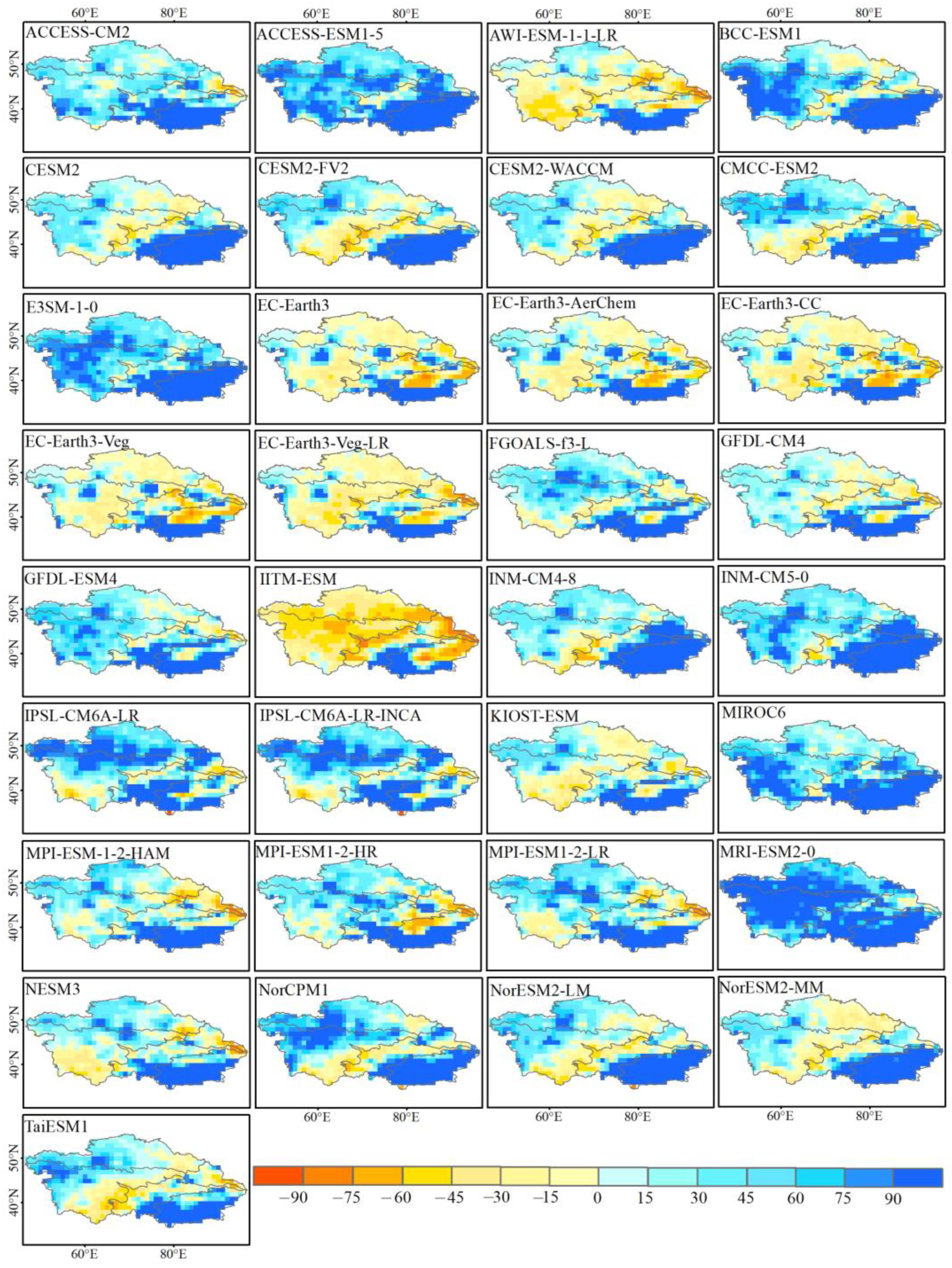
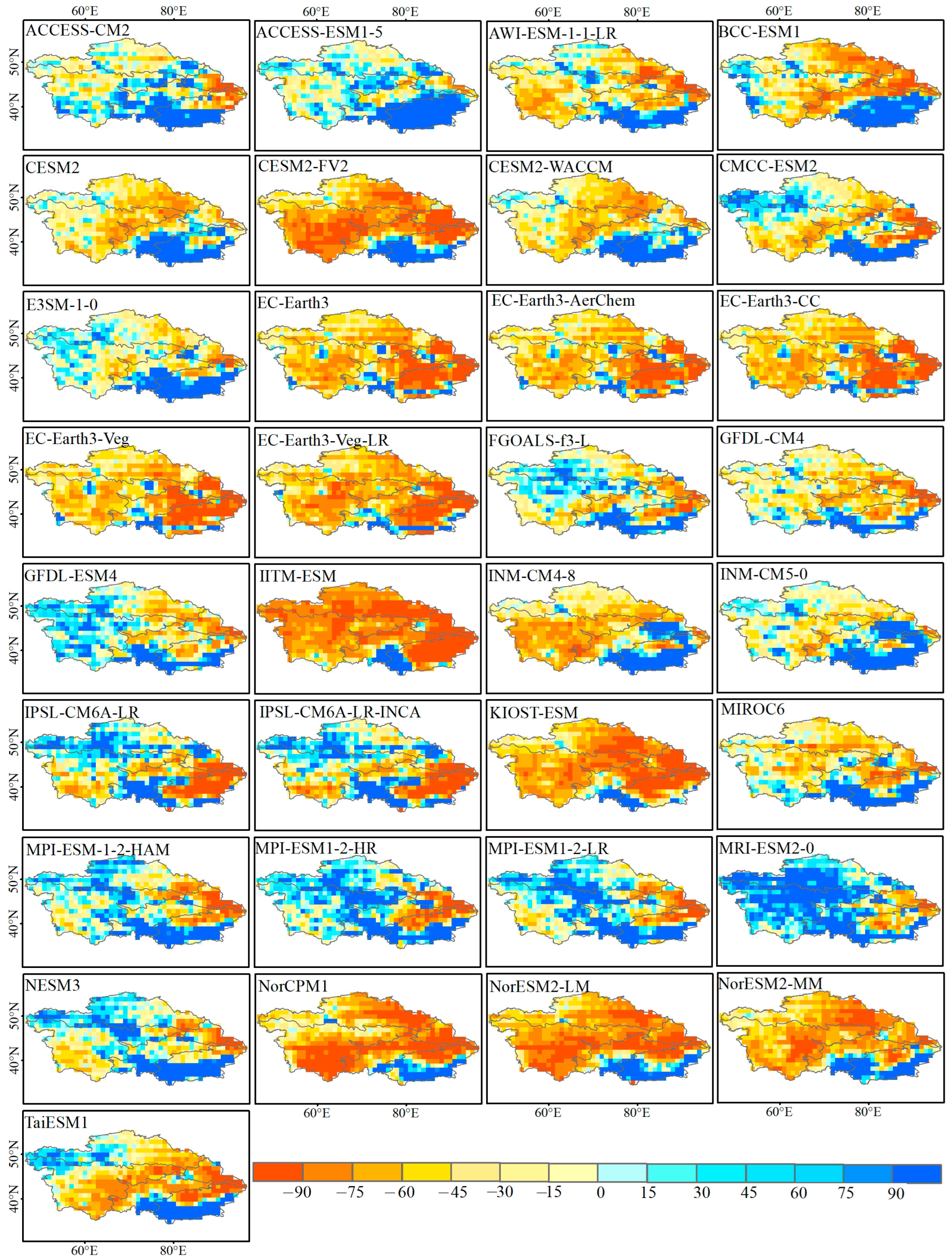
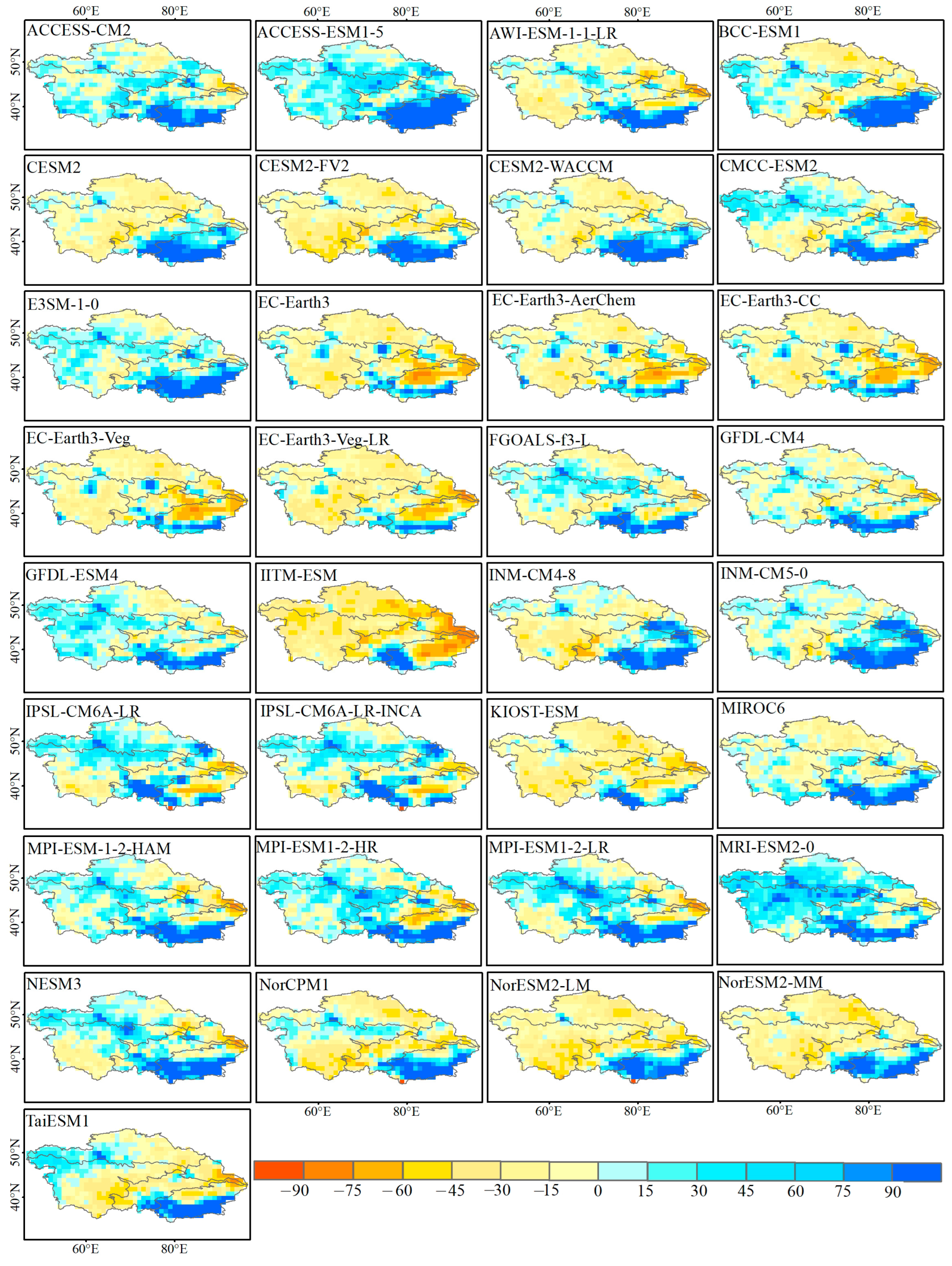
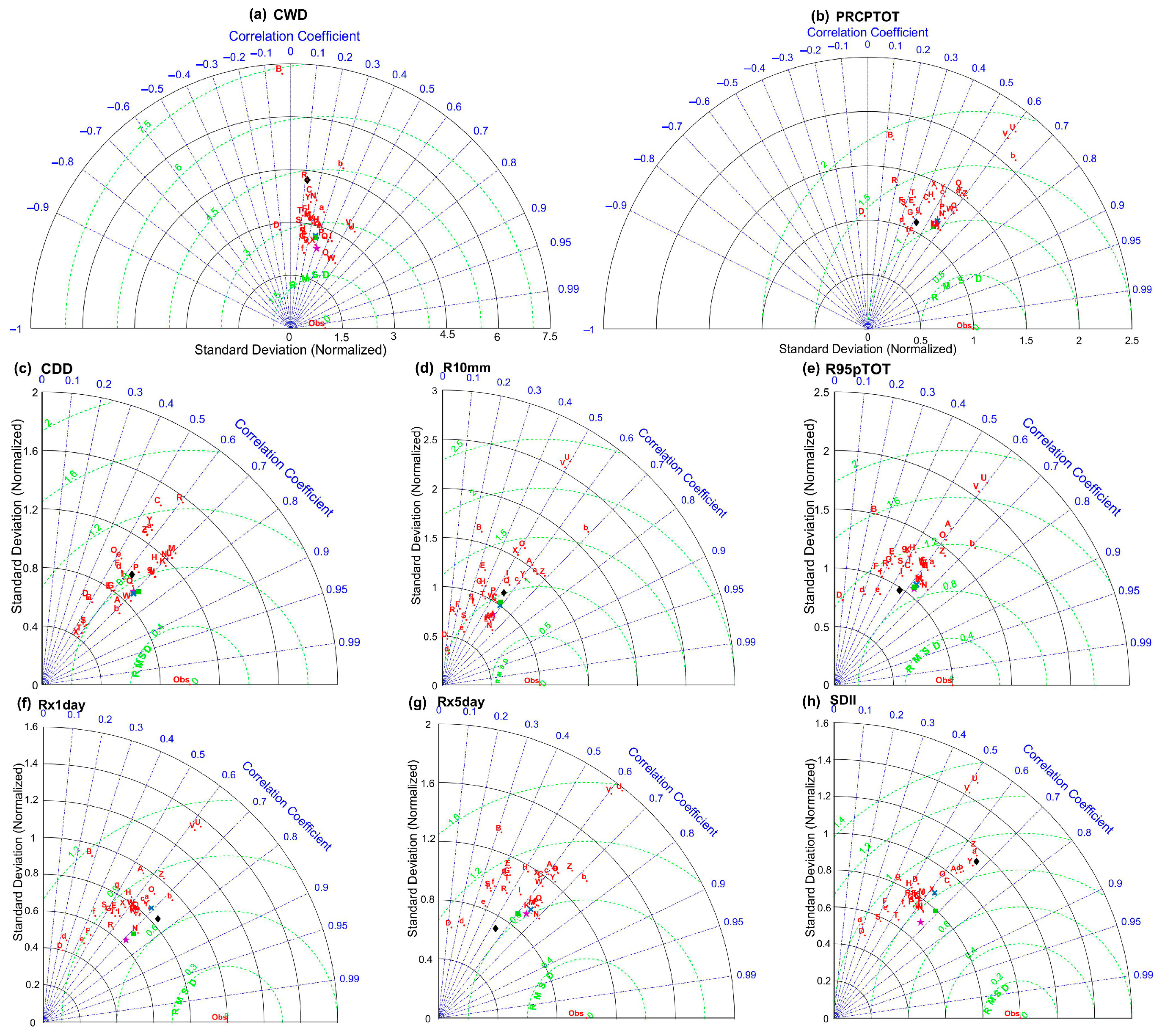
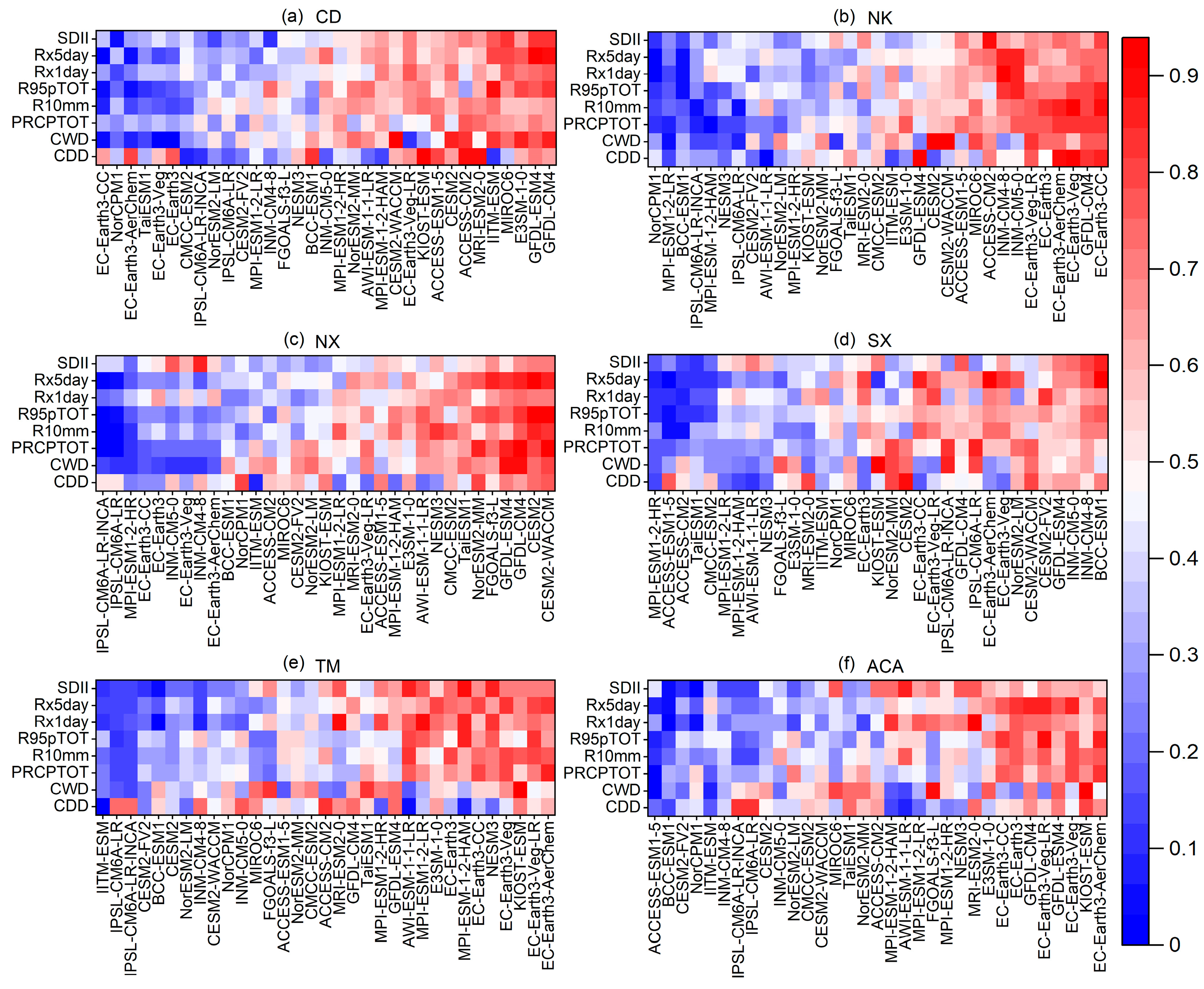
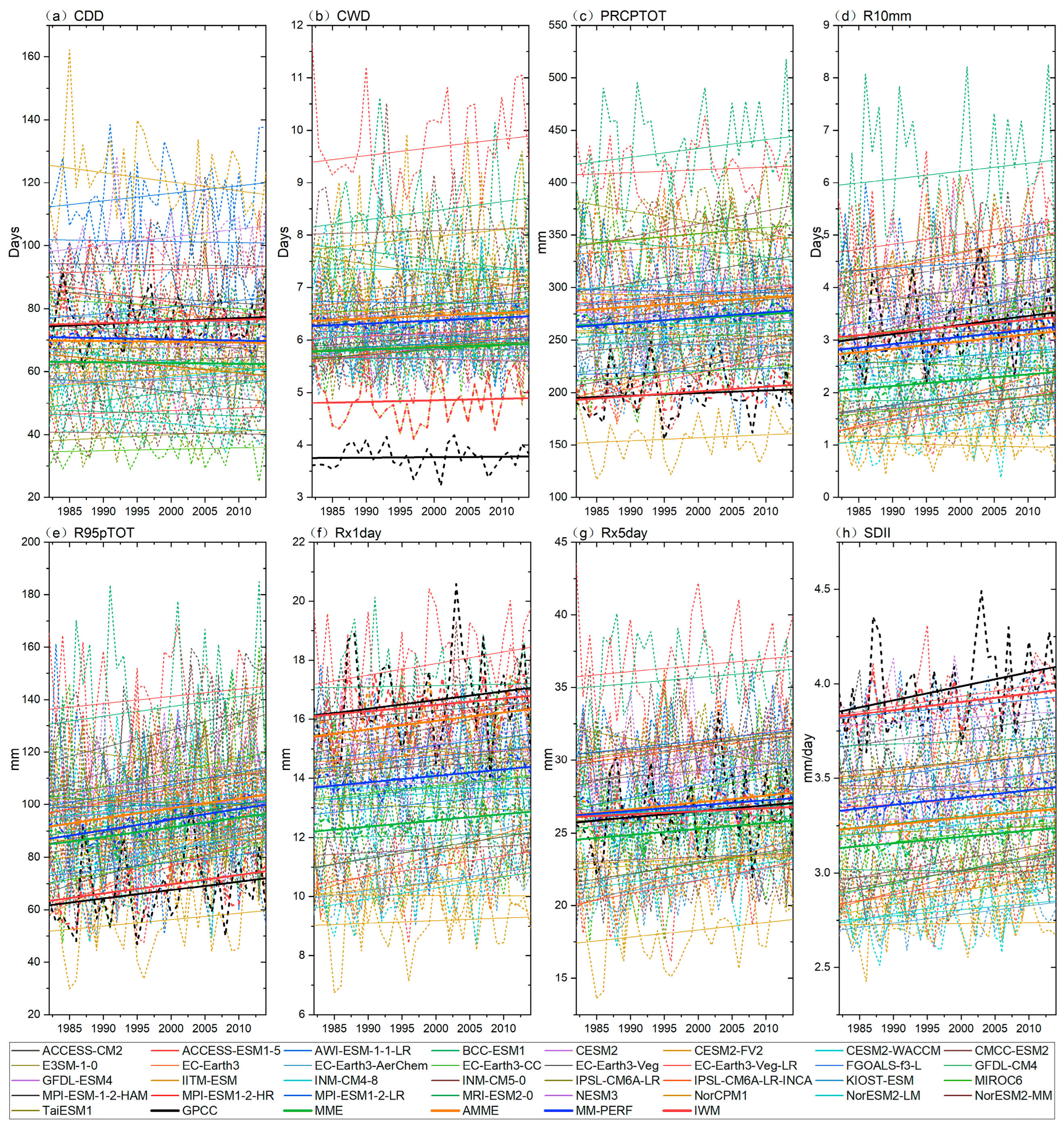
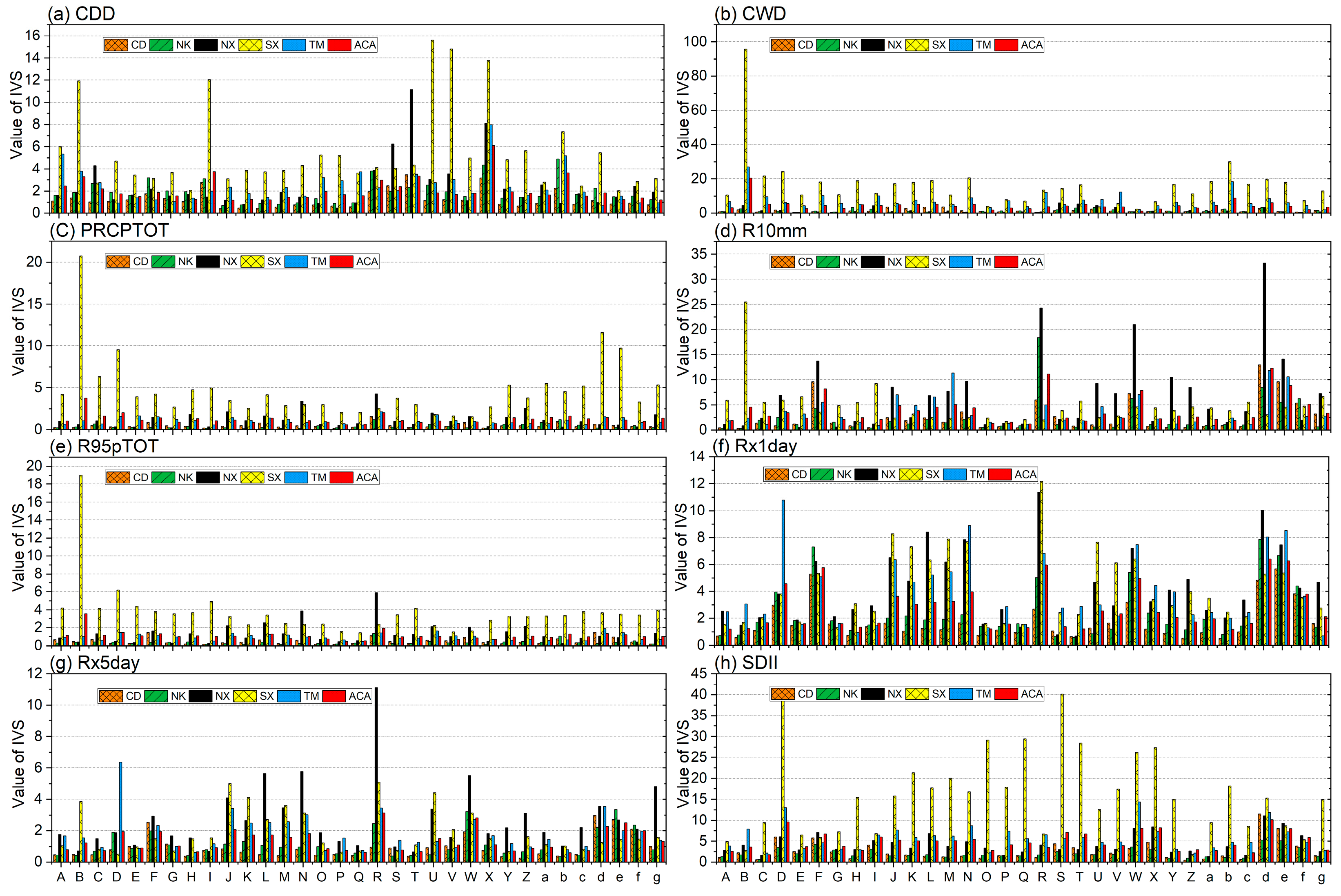
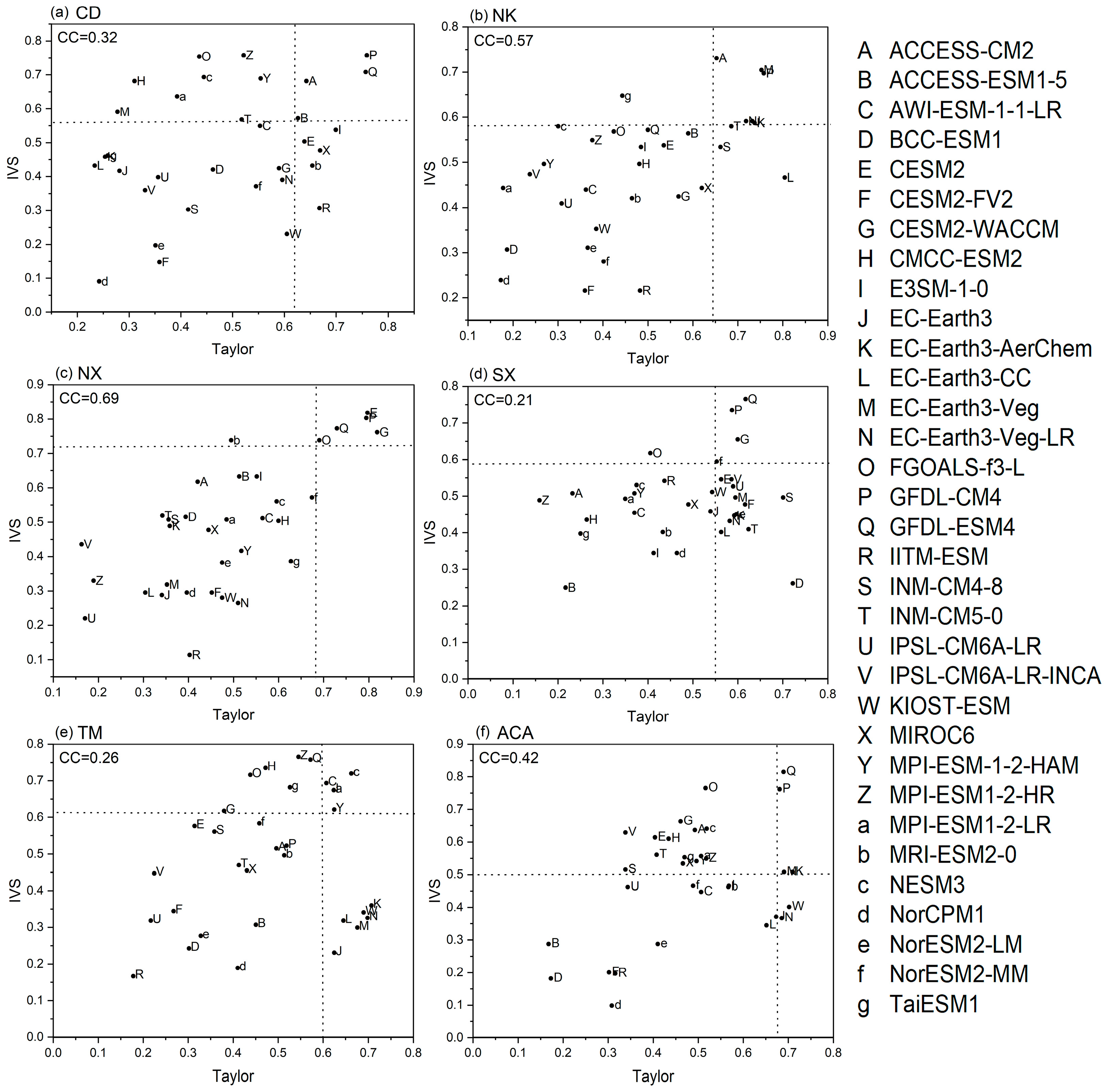


| ID | Model | Institution/Country | Resolution (Lon × Lat) |
|---|---|---|---|
| A | ACCESS-CM2 | CSIRO/Australia | 192 × 144 |
| B | ACCESS-ESM1-5 | CSIRO/Australia | 192 × 145 |
| C | AWI-ESM-1-1-LR | AWI/Germany | 192 × 96 |
| D | BCC-ESM1 | BCC/China | 128 × 64 |
| E | CESM2 | NCAR/USA | 288 × 192 |
| F | CESM2-FV2 | NCAR/USA | 144 × 96 |
| G | CESM2-WACCM | NCAR/USA | 288 × 192 |
| H | CMCC-ESM2 | CMCC/Italy | 288 × 192 |
| I | E3SM-1-0 | LLNL/USA | 360 × 180 |
| J | EC-Earth3 | EC-Earth-Consortium/Europe | 512 × 256 |
| K | EC-Earth3-AerChem | EC-Earth-Consortium/Europe | 512 × 256 |
| L | EC-Earth3-CC | EC-Earth-Consortium/Europe | 512 × 256 |
| M | EC-Earth3-Veg | EC-Earth-Consortium/Europe | 512 × 256 |
| N | EC-Earth3-Veg-LR | EC-Earth-Consortium/Europe | 320 × 160 |
| O | FGOALS-f3-L | CAS/China | 288 × 180 |
| P | GFDL-CM4 | NOAA-GFDL | 288 × 180 |
| Q | GFDL-ESM4 | NOAA-GFDL | 288 × 180 |
| R | IITM-ESM | CCCR-IITM | 192 × 94 |
| S | INM-CM4-8 | INM/Russia | 180 × 120 |
| T | INM-CM5-0 | INM/Russia | 180 × 120 |
| U | IPSL-CM6A-LR | IPSL/France | 144 × 143 |
| V | IPSL-CM6A-LR-INCA | IPSL/France | 144 × 143 |
| W | KIOST-ESM | KIOST/Korea | 192 × 96 |
| X | MIROC6 | MIROC/Japan | 256 × 128 |
| Y | MPI-ESM-1-2-HAM | HAMMOZ-Constortium | 192 × 96 |
| Z | MPI-ESM1-2-HR | MPI-M/Germany | 384 × 192 |
| a | MPI-ESM1-2-LR | MPI-M/Germany | 192 × 96 |
| b | MRI-ESM2-0 | MRI/Japan | 320 × 160 |
| c | NESM3 | NUIST/China | 192 × 96 |
| d | NorCPM1 | NCC/Norway | 144 × 96 |
| e | NorESM2-LM | NCC/Norway | 144 × 96 |
| f | NorESM2-MM | NCC/Norway | 288 × 192 |
| g | TaiESM1 | AS-RCEC/China | 288 × 192 |
| Category | Index | Definition | Units |
|---|---|---|---|
| Intensity indices | PRCPTOT | Annual total precipitation in wet days | mm |
| Rx1day | Annual maximum 1-day precipitation | mm | |
| Rx5day | Annual maximum consecutive 5-day precipitation | mm | |
| SDII | Simple precipitation intensity index | mm/day | |
| Frequency indices | R10mm | Annual count of days when RR ≥ 10 mm | days |
| Duration indices | CDD | Maximum length of dry spell, maximum number of consecutive days with RR < 1 mm | days |
| CWD | Maximum length of wet spell, maximum number of consecutive days with RR ≥ 1 mm | days | |
| Percentile-based threshold indices | R95pTOT | Annual total precipitation when RR > 95th percentile | mm |
| Model | CDD | CWD | PRCPTOT | R10mm | R95pTOT | Rx1day | Rx5day | SDII |
|---|---|---|---|---|---|---|---|---|
| ACCESS-CM2 | 0.245 | 0.476 ** | 0.350 * | 0.146 | 0.264 | −0.131 | 0.111 | −0.181 |
| ACCESS-ESM1-5 | 0.293 | −0.004 | −0.052 | −0.212 | −0.109 | −0.208 | −0.249 | −0.016 |
| AWI-ESM-1-1-LR | 0.371 * | −0.084 | −0.140 | −0.065 | −0.043 | 0.013 | −0.190 | −0.074 |
| BCC-ESM1 | −0.241 | 0.145 | 0.090 | 0.309 | 0.148 | 0.189 | 0.368 * | 0.198 |
| CESM2 | 0.064 | −0.117 | 0.168 | 0.168 | 0.221 | −0.014 | 0.091 | 0.122 |
| CESM2-FV2 | 0.427 * | −0.128 | 0.192 | 0.169 | 0.151 | 0.033 | −0.004 | 0.087 |
| CESM2-WACCM | −0.068 | −0.109 | 0.045 | 0.122 | 0.188 | 0.165 | 0.181 | 0.257 |
| CMCC-ESM2 | 0.046 | −0.022 | 0.007 | −0.029 | 0.028 | 0.097 | 0.130 | 0.041 |
| E3SM-1-0 | 0.306 | −0.232 | 0.052 | −0.099 | −0.069 | −0.217 | −0.335 | −0.059 |
| EC-Earth3 | 0.010 | 0.018 | 0.053 | 0.108 | 0.140 | 0.027 | −0.022 | 0.164 |
| EC-Earth3-AerChem | −0.479 ** | 0.017 | −0.168 | −0.019 | −0.043 | −0.139 | −0.051 | 0.009 |
| EC-Earth3-CC | 0.247 | 0.146 | 0.290 | 0.223 | 0.243 | 0.159 | 0.159 | 0.112 |
| EC-Earth3-Veg | −0.237 | −0.155 | 0.002 | 0.105 | 0.122 | 0.247 | 0.097 | 0.368 * |
| EC-Earth3-Veg-LR | 0.122 | −0.020 | 0.193 | 0.108 | 0.110 | 0.089 | −0.047 | 0.041 |
| FGOALS-f3-L | −0.134 | −0.015 | 0.100 | 0.170 | 0.189 | 0.123 | 0.160 | 0.277 |
| GFDL-CM4 | 0.049 | −0.051 | −0.273 | −0.229 | −0.159 | −0.155 | −0.154 | 0.069 |
| GFDL-ESM4 | 0.097 | −0.303 | −0.093 | 0.060 | 0.031 | 0.081 | 0.094 | 0.161 |
| IITM-ESM | 0.088 | −0.062 | 0.217 | 0.187 | 0.260 | 0.130 | 0.138 | 0.305 |
| INM-CM4-8 | −0.044 | 0.272 | 0.234 | 0.170 | 0.252 | 0.079 | 0.080 | 0.121 |
| INM-CM5-0 | −0.013 | 0.235 | 0.163 | 0.231 | 0.273 | 0.159 | 0.232 | 0.314 |
| IPSL-CM6A-LR | −0.012 | −0.173 | 0.187 | 0.194 | 0.178 | −0.079 | −0.049 | 0.080 |
| IPSL-CM6A-LR-INCA | 0.164 | 0.164 | −0.219 | −0.303 | −0.164 | 0.026 | 0.193 | 0.075 |
| KIOST-ESM | −0.038 | 0.129 | −0.227 | −0.059 | −0.257 | −0.252 | −0.034 | −0.227 |
| MIROC6 | 0.021 | −0.043 | 0.123 | 0.193 | 0.186 | 0.176 | 0.100 | 0.209 |
| MPI-ESM-1-2-HAM | −0.121 | −0.207 | −0.191 | −0.088 | −0.021 | −0.105 | −0.176 | 0.067 |
| MPI-ESM1-2-HR | −0.141 | −0.286 | −0.017 | 0.102 | 0.148 | 0.234 | 0.050 | 0.185 |
| MPI-ESM1-2-LR | −0.211 | −0.095 | −0.029 | 0.122 | 0.141 | 0.109 | 0.086 | 0.342 |
| MRI-ESM2-0 | 0.102 | 0.086 | 0.094 | 0.072 | 0.144 | 0.301 | 0.288 | 0.186 |
| NESM3 | −0.101 | −0.035 | 0.225 | 0.150 | 0.110 | 0.037 | 0.087 | −0.016 |
| NorCPM1 | 0.081 | 0.289 | 0.044 | 0.119 | 0.143 | 0.067 | 0.221 | 0.217 |
| NorESM2-LM | −0.359 * | −0.188 | −0.231 | −0.172 | −0.198 | 0.008 | −0.162 | −0.012 |
| NorESM2-MM | 0.025 | 0.023 | 0.118 | 0.191 | 0.179 | 0.177 | 0.147 | 0.146 |
| TaiESM1 | 0.145 | 0.011 | 0.108 | 0.159 | 0.127 | 0.127 | 0.076 | 0.309 |
Disclaimer/Publisher’s Note: The statements, opinions and data contained in all publications are solely those of the individual author(s) and contributor(s) and not of MDPI and/or the editor(s). MDPI and/or the editor(s) disclaim responsibility for any injury to people or property resulting from any ideas, methods, instructions or products referred to in the content. |
© 2023 by the authors. Licensee MDPI, Basel, Switzerland. This article is an open access article distributed under the terms and conditions of the Creative Commons Attribution (CC BY) license (https://creativecommons.org/licenses/by/4.0/).
Share and Cite
Lei, X.; Xu, C.; Liu, F.; Song, L.; Cao, L.; Suo, N. Evaluation of CMIP6 Models and Multi-Model Ensemble for Extreme Precipitation over Arid Central Asia. Remote Sens. 2023, 15, 2376. https://doi.org/10.3390/rs15092376
Lei X, Xu C, Liu F, Song L, Cao L, Suo N. Evaluation of CMIP6 Models and Multi-Model Ensemble for Extreme Precipitation over Arid Central Asia. Remote Sensing. 2023; 15(9):2376. https://doi.org/10.3390/rs15092376
Chicago/Turabian StyleLei, Xiaoni, Changchun Xu, Fang Liu, Lingling Song, Linlin Cao, and Nanji Suo. 2023. "Evaluation of CMIP6 Models and Multi-Model Ensemble for Extreme Precipitation over Arid Central Asia" Remote Sensing 15, no. 9: 2376. https://doi.org/10.3390/rs15092376





